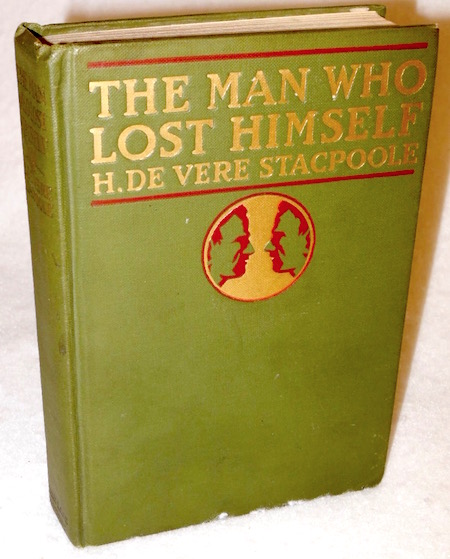THE MAN WHO LOST HIMSELF (5)
By:
March 8, 2018

This year marks the 100th anniversary of a forgotten Avenger/Artful Dodger-type adventure novel, The Man Who Lost Himself. A man down on his luck wakes up after a drunken night in London only to discover… that he has somehow slipped into the identity of a wealthy aristocrat! HiLoBooks is pleased to serialize this funny, thrilling yarn by H. De Vere Stacpoole — best known as author of The Blue Lagoon — here at HILOBROW.

Out in the open air and sunshine he took a deep satisfying breath. He felt as though he had escaped from a cage full of monkeys. Monkeys in the form of men, creatures who would servilely obey him as Rochester, but who, scenting the truth, would rend him in pieces.
Well, he was clear of them. Once back in the Savoy he would get into his own things, and once in his own things he would strike. If he could not get a lawyer to take his case up against Rochester, he would go to the police. Yes, he would. Rochester had doped him, taken his letters, taken his watch.
Jones was not the man to bring false charges. He knew that in taking his belongings, this infernal jester had done so, not for plunder, but for the purpose of making the servants believe that he, Rochester, had been stripped of everything by sharks, and sent home in an old suit of clothes; all the same he would charge Rochester with the taking of his things, he would teach this practical joker how to behave.
To cool himself and collect his thoughts before going to the Savoy, he took a walk in the Green Park.
That one word “Tosh!” uttered by the woman, in answer to what he had said, told him more about Rochester than many statements. This man wanted a cold bath, he wanted to be held under the tap till he cried for mercy.
Walking, now with the stick under his right arm and his left hand in his trousers pocket, he felt something in the pocket. It was a coin. He took it out. It was a penny, undiscovered evidently, and unremoved by the valet.
It was also a reminder of his own poverty-stricken condition. His thoughts turned from Rochester and his jokes, to his own immediate and tragic position. The whole thing was his own fault. It was quite easy to say that Rochester had led him along and tempted him; he was a full grown man and should have resisted temptation. He had let strong drink get hold of him; well, he had paid by the loss of his money, to say nothing of the way his self-respect had been bruised by this jester.
Near Buckingham Palace he turned back, walking by the way he had come, and leaving the park at the new gate.
He crossed the plexus of ways where Northumberland Avenue debouches on Trafalgar Square. It was near twelve o’clock, and the first evening papers were out. A hawker with a bundle of papers under his arm and a yellow poster in front of him like an apron, drew his attention; at least the poster did.
“Suicide of an American in London!” were the words on the poster.
Jones, remembering his penny, produced it and bought a paper.
The American’s suicide did not interest him, but he fancied vaguely that something of Rochester’s doings of the night before might have been caught by the Press through the Police news. He thought it highly probable that Rochester, continuing his mad course, had been gaoled.
He was rewarded. Right on the first page he saw his own name. He had never seen it before in print, and the sight and the circumstances made his tongue cluck back, as though checked by a string tied to its root.
This was the paragraph:
Last night, as the 11.35 Inner Circle train was entering the Temple Station, a man was seen to jump from the platform on to the metals. Before the station officials could interfere to save him, the unfortunate man had thrown himself before the incoming engine. Death was instantaneous.
From papers in possession of deceased, his identity has been verified as that of Mr. V.A. Jones, an American gentleman of Philadelphia, lately resident at the Savoy Hotel, Strand.
Jones stood with the paper in his hand, appalled. Rochester had committed suicide!
This was the Jest — the black core of it. All last evening, all through that hilarity he had been plotting this. Plotting it perhaps from the first moment of their meeting. Unable to resist the prompting of the extraordinary likeness, this joker, this waster, done to the world, had left life at the end of a last jamboree, and with a burst of laughter —leaving another man in his clothes, nay, almost one might say in his body.
Jones saw the point of the thing at once.
SERIALIZED BY HILOBOOKS: Jack London’s The Scarlet Plague | Rudyard Kipling’s With the Night Mail (and “As Easy as A.B.C.”) | Arthur Conan Doyle’s The Poison Belt | H. Rider Haggard’s When the World Shook | Edward Shanks’ The People of the Ruins | William Hope Hodgson’s The Night Land | J.D. Beresford’s Goslings | E.V. Odle’s The Clockwork Man | Cicely Hamilton’s Theodore Savage | Muriel Jaeger’s The Man With Six Senses | Jack London’s “The Red One” | Philip Francis Nowlan’s Armageddon 2419 A.D. | Homer Eon Flint’s The Devolutionist | W.E.B. DuBois’s “The Comet” | Edgar Rice Burroughs’s The Moon Men | Charlotte Perkins Gilman’s Herland | Sax Rohmer’s “The Zayat Kiss” | Eimar O’Duffy’s King Goshawk and the Birds | Frances Hodgson Burnett’s The Lost Prince | Morley Roberts’s The Fugitives | Helen MacInnes’s The Unconquerable | Geoffrey Household’s Watcher in the Shadows | William Haggard’s The High Wire | Hammond Innes’s Air Bridge | James Branch Cabell’s Jurgen | John Buchan’s “No Man’s Land” | John Russell’s “The Fourth Man” | E.M. Forster’s “The Machine Stops” | John Buchan’s Huntingtower | Arthur Conan Doyle’s When the World Screamed | Victor Bridges’ A Rogue By Compulsion | Jack London’s The Iron Heel | H. De Vere Stacpoole’s The Man Who Lost Himself | P.G. Wodehouse’s Leave It to Psmith | Richard Connell’s “The Most Dangerous Game” | Houdini and Lovecraft’s “Imprisoned with the Pharaohs” | Arthur Conan Doyle’s “The Sussex Vampire.”
RADIUM AGE SCIENCE FICTION: “Radium Age” is HILOBROW’s name for the 1904–33 era, which saw the discovery of radioactivity, the revelation that matter itself is constantly in movement — a fitting metaphor for the first decades of the 20th century, during which old scientific, religious, political, and social certainties were shattered. This era also saw the publication of genre-shattering writing by Edgar Rice Burroughs, Sax Rohmer, E.E. “Doc” Smith, Jack London, Arthur Conan Doyle, Aldous Huxley, Olaf Stapledon, Karel Čapek, H.P. Lovecraft, Charlotte Perkins Gilman, Yevgeny Zamyatin, Philip Gordon Wylie, and other pioneers of post-Verne/Wells, pre-Golden Age “science fiction.” More info here.
READ GORGEOUS PAPERBACKS: HiLoBooks has reissued the following 10 obscure but amazing Radium Age science fiction novels in beautiful print editions: Jack London’s The Scarlet Plague, Rudyard Kipling’s With the Night Mail (and “As Easy as A.B.C.”), Arthur Conan Doyle’s The Poison Belt, H. Rider Haggard’s When the World Shook, Edward Shanks’ The People of the Ruins, William Hope Hodgson’s The Night Land, J.D. Beresford’s Goslings, E.V. Odle’s The Clockwork Man, Cicely Hamilton’s Theodore Savage, and Muriel Jaeger’s The Man with Six Senses. For more information, visit the HiLoBooks homepage.
